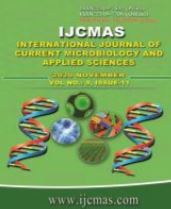


 National Academy of Agricultural Sciences (NAAS)
National Academy of Agricultural Sciences (NAAS)

|
PRINT ISSN : 2319-7692
Online ISSN : 2319-7706 Issues : 12 per year Publisher : Excellent Publishers Email : editorijcmas@gmail.com / submit@ijcmas.com Editor-in-chief: Dr.M.Prakash Index Copernicus ICV 2018: 95.39 NAAS RATING 2020: 5.38 |
Odisha is home to a good number of short grained indigenous aromatic rice (Oryza sativa L.) cultivars and these precious land races are flourishing well in local agro-climatic conditions with thermostable aroma. There is a tremendous scope for augmenting the exportable qualities of these traditional cultivars with highly stable yield performance. Hence in the present study, random amplified polymorphic DNA technique was employed for genetic diversity analysis of 19 rice cultivars (16 scented and 3 non-scented) of Odisha. Out of 50 bands amplified by 10 arbitrary decamer oligonucleotide primers, 34 were found to be polymorphic and the rest were monomorphic. The pair-wise genetic similarity coefficients varied from 0.51 between Jhillipanjari and Deulabhog to 0.95 between Acharmati and Dhobaluchi. The UPGMA cluster analysis classified all the cultivars into two major groups separating the non-aromatic rice varieties from the aromatic ones. Maximum genetic diversity was observed between Deulabhog and Jhillipanjari. High degree of genetic similarity among the short grained cultivars like Acharmati, Dhobaluchi, Deulabhog, Dubrajsena and Basnadhan (average similarity >0.93) indicated that those might be the selections made by the farmers from a single land race.
 |
 |
 |
 |
 |